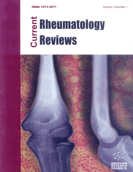
Abstract
Background: Adult-onset Still’s disease and systemic-onset juvenile idiopathic arthritis constitute two sides of the same continuum disease. We aimed to investigate the similarities and differences between those diseases.
Methods: We conducted a retrospective study including adult patients affected by still’s disease, attending the rheumatology department and patients affected by systemic-onset juvenile idiopathic arthritis attending the pediatric department. We recorded clinical and radiological findings, different therapeutic regimens, and disease patterns.
Results: There were 8 adult patients (6 females and 2 males) and 8 juvenile patients (4 females and 4 males). The classical triad of spiking fever, arthritis, and evanescent skin rash was the first clinical presentation observed in 4 adult patients and in 2 juvenile patients. Arthritis was noted in 8 adult patients versus 6 juvenile patients. Joint deformities were seen in adult patients. Non-steroid antiinflammatory drugs and corticosteroids were the most prescribed molecules. csDMARDs and bDMARDs were used in second-line therapy only for adult patients. The monocyclic course was predominant in juvenile patients and the polycyclic course in adult patients. The chronic course was observed only in two adult patients. Remission was noted in 5 adult patients and 6 juvenile patients. There were no significant differences between the two groups regarding clinical findings, different therapeutic regimens, and disease patterns.
Conclusion: From the findings of our study, it seems that AOSD and sJIA are the same syndrome continuum expressed in different hosts. This hypothesis is supported by clinical course, molecule evidence, cytokine profile, and treatment response.
Keywords: Adult-onset still’s disease, arthritis juvenile, comparative study, arthritis, interleukin 1 receptor antagonist protein, tumor necrosis factor inhibitors.
Graphical Abstract
[http://dx.doi.org/10.1016/j.semarthrit.2021.06.004] [PMID: 34175791]
[http://dx.doi.org/10.2188/jea.7.221] [PMID: 9465547]
[PMID: 14760812]
[http://dx.doi.org/10.53738/REVMED.2018.14.594.0372] [PMID: 29461751]
[http://dx.doi.org/10.3899/jrheum.080365] [PMID: 19273456]
[http://dx.doi.org/10.4103/idoj.IDOJ_383_20] [PMID: 34667762]
[http://dx.doi.org/10.1007/s12026-014-8561-9] [PMID: 25388963]
[http://dx.doi.org/10.1016/j.clim.2016.05.010] [PMID: 27263804]
[http://dx.doi.org/10.1186/s12969-015-0047-3] [PMID: 26589963]
[http://dx.doi.org/10.1007/s10067-005-0138-5] [PMID: 16365690]
[PMID: 12102485]
[http://dx.doi.org/10.1007/s100670050030] [PMID: 10791624]
[PMID: 1767345]
[http://dx.doi.org/10.1186/s41927-019-0053-z] [PMID: 30886992]
[PMID: 1578458]
[http://dx.doi.org/10.1136/ard.2005.042143] [PMID: 16219707]
[http://dx.doi.org/10.1155/2012/271569] [PMID: 22235382]
[http://dx.doi.org/10.1007/s10067-017-3830-3] [PMID: 28914368]
[http://dx.doi.org/10.1016/j.autrev.2014.08.032] [PMID: 25183244]
[http://dx.doi.org/10.1002/acr.22194] [PMID: 24124073]
[http://dx.doi.org/10.1038/gene.2012.3] [PMID: 22418018]
[http://dx.doi.org/10.1097/BOR.0b013e32825a6a79] [PMID: 17762614]
[http://dx.doi.org/10.1016/j.semarthrit.2019.08.005] [PMID: 31488308]
[http://dx.doi.org/10.1038/sj.gene.6363922] [PMID: 12424620]
[PMID: 15517632]
[http://dx.doi.org/10.1002/art.38615] [PMID: 24623686]
[http://dx.doi.org/10.1093/rheumatology/keq284] [PMID: 20837500]
[http://dx.doi.org/10.1056/NEJMoa1112802] [PMID: 23252525]
[http://dx.doi.org/10.1136/annrheumdis-2018-213030] [PMID: 29643108]
[http://dx.doi.org/10.1186/s13075-017-1462-2] [PMID: 29166924]
[http://dx.doi.org/10.1186/s12969-017-0196-7] [PMID: 28830457]
[http://dx.doi.org/10.3389/fphar.2019.00918] [PMID: 31507416]
[http://dx.doi.org/10.1186/s13075-019-1838-6] [PMID: 30755262]
[http://dx.doi.org/10.1016/j.semarthrit.2010.12.006] [PMID: 21377714]
[http://dx.doi.org/10.3390/jcm10122633] [PMID: 34203779]
[http://dx.doi.org/10.1186/s13075-021-02688-4] [PMID: 34879864]
[http://dx.doi.org/10.1007/s10067-021-05722-7] [PMID: 34002352]
[http://dx.doi.org/10.1007/s11926-996-0006-6] [PMID: 11564367]









